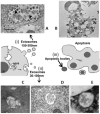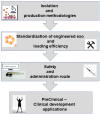Overview and Update on Extracellular Vesicles: Considerations on Exosomes and Their Application in Modern Medicine
- PMID: 35741325
- PMCID: PMC9220244
- DOI: 10.3390/biology11060804
Overview and Update on Extracellular Vesicles: Considerations on Exosomes and Their Application in Modern Medicine
Abstract
In recent years, there has been a rapid growth in the knowledge of cell-secreted extracellular vesicle functions. They are membrane enclosed and loaded with proteins, nucleic acids, lipids, and other biomolecules. After being released into the extracellular environment, some of these vesicles are delivered to recipient cells; consequently, the target cell may undergo physiological or pathological changes. Thus, extracellular vesicles as biological nano-carriers, have a pivotal role in facilitating long-distance intercellular communication. Understanding the mechanisms that mediate this communication process is important not only for basic science but also in medicine. Indeed, extracellular vesicles are currently seen with immense interest in nanomedicine and precision medicine for their potential use in diagnostic, prognostic, and therapeutic applications. This paper aims to summarize the latest advances in the study of the smallest subtype among extracellular vesicles, the exosomes. The article is divided into several sections, focusing on exosomes' nature, characteristics, and commonly used strategies and methodologies for their separation, characterization, and visualization. By searching an extended portion of the relevant literature, this work aims to give a quick outline of advances in exosomes' extensive nanomedical applications. Moreover, considerations that require further investigations before translating them to clinical applications are summarized.
Keywords: drug delivery systems; exosomes characterization; extracellular vesicles; nanomedicine.
Conflict of interest statement
The author declares no conflict of interest.
Figures











Similar articles
-
Extracellular Vesicles: Diagnostic and Therapeutic Applications in Cancer.Biology (Basel). 2024 Sep 12;13(9):716. doi: 10.3390/biology13090716. Biology (Basel). 2024. PMID: 39336143 Free PMC article. Review.
-
Extracellular Vesicles as New Players in Drug Delivery: A Focus on Red Blood Cells-Derived EVs.Pharmaceutics. 2023 Jan 21;15(2):365. doi: 10.3390/pharmaceutics15020365. Pharmaceutics. 2023. PMID: 36839687 Free PMC article. Review.
-
[Research advances of liposomes and exosomes in drug delivery and biomarker screening].Se Pu. 2025 May;43(5):472-486. doi: 10.3724/SP.J.1123.2024.08012. Se Pu. 2025. PMID: 40331611 Free PMC article. Review. Chinese.
-
Biogenesis, Membrane Trafficking, Functions, and Next Generation Nanotherapeutics Medicine of Extracellular Vesicles.Int J Nanomedicine. 2021 May 18;16:3357-3383. doi: 10.2147/IJN.S310357. eCollection 2021. Int J Nanomedicine. 2021. PMID: 34040369 Free PMC article. Review.
-
Extracellular Vesicles as Promising Carriers in Drug Delivery: Considerations from a Cell Biologist's Perspective.Biology (Basel). 2021 Apr 27;10(5):376. doi: 10.3390/biology10050376. Biology (Basel). 2021. PMID: 33925620 Free PMC article. Review.
Cited by
-
The Increasing Diagnostic Role of Exosomes in Inflammatory Diseases to Leverage the Therapeutic Biomarkers.J Inflamm Res. 2024 Jul 25;17:5005-5024. doi: 10.2147/JIR.S475102. eCollection 2024. J Inflamm Res. 2024. PMID: 39081872 Free PMC article. Review.
-
Melatonin and TGF-β-Mediated Release of Extracellular Vesicles.Metabolites. 2023 Apr 18;13(4):575. doi: 10.3390/metabo13040575. Metabolites. 2023. PMID: 37110233 Free PMC article. Review.
-
Medical Relevance, State-of-the-Art and Perspectives of "Sweet Metacode" in Liquid Biopsy Approaches.Diagnostics (Basel). 2024 Mar 28;14(7):713. doi: 10.3390/diagnostics14070713. Diagnostics (Basel). 2024. PMID: 38611626 Free PMC article. Review.
-
A Comparative Analysis of Naïve Exosomes and Enhanced Exosomes with a Focus on the Treatment Potential in Ovarian Disorders.J Pers Med. 2024 Apr 30;14(5):482. doi: 10.3390/jpm14050482. J Pers Med. 2024. PMID: 38793064 Free PMC article.
-
Systematic characterization of extracellular vesicles from potato (Solanum tuberosum cv. Laura) roots and peels: biophysical properties and proteomic profiling.Front Plant Sci. 2024 Nov 15;15:1477614. doi: 10.3389/fpls.2024.1477614. eCollection 2024. Front Plant Sci. 2024. PMID: 39619839 Free PMC article.
References
-
- Drexler E.K., Peterson C., Pergamit G. Unbounding the Future: The Nanothechnology Revolution. William Morrow and Company, Inc.; New York, NY, USA: 1991.
-
- Chidambaran M., Manavalan R., Kathiresan K. Nanotherapeutics to overcome conventional cancer chemotherapy limitations. J. Pharm. Sci. 2011;14:67–77. - PubMed
Publication types
LinkOut - more resources
Full Text Sources

